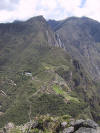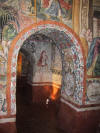| |
I traveled in
Peru and Bolivia with my brother for two weeks in November 2002 |
 |
Airport of Arequipa (2,350m).
Arequipa is a nice colonial town 1 hour flight south of Lima. |
 |
From Cayma, a suburb of Arequipa,
one has beautiful view across the green valley to the volcanoes Chachani
(6,075m) and Misti (5,822m) |
 |
Inside Santa Catalina which
was a very high profile monetary. Once a nun had entered no contact
whatsoever with the outside world was allowed. This monastery had not been
accessible for outsiders for centuries. The nuns had not a very bad life, as
they had servants to help them with their daily chores. |
 |
The famous laundry area in Santa
Catalina. |
 |
The amazingly
clean streets of Arequipa (it isn't any better in Switzerland). |
 |
The facade of
the main cathedral at the main square (Plaza de Armas). The square is
completely surrounded by arcades buildings like to the one on the right hand
side of the picture (which actually was our hotel).
Please also see the video
(1,812KB). |
 |
View across
the main square |
 |
dito |
 |
Between
Arequipa and Puno on a high plateau (4,000m to 4,500m) where the Vicuñas
(relatives of the Lamas and Alpacas) have a refuge. |
 |
Chulpas (grave
towers) on lake Umayo in Sillustani. These Chulpas were built by the Colla
culture before the time of the Incas. The Collas speak Aymara (contrary to
the Incas who speak Quechua). Aymara is still today spoken in the region
around Lake Titicaca. |
 |
More Chulpas |
 |
Lake Titicaca
(3,820m high, 3,833km2 big) with the Cordillera Real (up to
6,500m high) in the background. |
 |
Copacabana
(Bolivia) on lake Titicaca. Copacabana is a famous place of pilgrimage. |
 |
Our hotel on
Isla del Sol, the island in Lake Titicaca where the first two Incas Manco
Capac and Mama Ocllo descended onto the word in 1200. |
 |
View from the
patio of our hotel. |
 |
The Cordillera
Real at sunset (as seen from Isla del Sol). |
 |
Girls coming
home from the meadows at night (Isla del Sol). |
 |
Our hydrofoil
approaching to pick us up. |
 |
José Limachi
who built the Kon Tiki for Thor Heyerdahl and who crossed with him the
Pacific still lives on Lake Titicaca (Huatajata). José was just about to
leave for the Easter Island where he was to build another boat for an
expedition. |
 |
On our way to
La Paz. |
 |
The upper
parts of La Paz (El Alto) are located at 4,000m where it is pretty cold in
winter. Hence the richer people live in the lower parts (not much above
3,000m). The center of La Paz with the football stadium is at 3,700m. |
 |
The main
square of La Paz (Paza Murillo). To the right of the right hand side clock
tower one sees a big indent in the otherwise densely built houses. That is
where rain has washed down 50 houses. Much of La Paz is built on instable
clay slopes. |
 |
Typical house
in the Altiplano (the high plateau around Lake Titicaca). Most of the people
here still live in houses like this. |
 |
Tiahuancao, a
splendid culture before the Incas. Unfortunately over the centuries most was
destroyed carelessly or on purpose. The Spanish were systematically erasing
all signs of non-Christian cultures. |
 |
The Templete
Semsiuberráneo in Tiahuanaco. One of the steles shows a figure with round
eyes, full lips and a beard which fuels speculations about visitors to the
region before the Spanish. |
 |
The stele
Ponce. The Spanish tried to behead it (as can be seen from the marks) as
they didn't succeed they baptized the figure buy engraving a cross. |
 |
Swimming
islands on Lake Titicaca built by the people called Uros. However, the last
pure Uro died at the end of the 1950ies and today these islands are more of
a tourist attraction than a real habitat. |
 |
Train from
Puno to Cusco. As always in Peru/Bolivia food was excellent also here. |
 |
Cruising
across the Altiplano. |
 |
Train stop at
the highest point (La Raya, 4,313m). |
 |
The main
square of Cusco (Plaza de Armas). Please also see
the video (1,524KB). |
 |
Typical Inca
walls in Cusco. The Incas built fantastic walls without any cement which fit
so perfectly that not even a razor blade can be squeeze in between the
individual stones. Those walls which were not torn down by the Spanish have
survived the centuries undamaged, despite the many earthquakes. |
 |
Perfect
masonry (we'll see more of it). |
 |
dito |
 |
Back on the
Plaza de Armas. |
 |
En route to
the holy valley of the Incas between Pisac and Urubamba. |
 |
Ollantaytambo,
an Inca fortress at the entrance to the holy valley. |
 |
More Inca
walls (please pay attention to the perfectly rounded edge) |
 |
Inca terraces
to grow food (these walls were not built to highest standard). |
 |
View of the
countryside on the way back to Cusco. |
 |
Sunset on the
way back to Cusco. |
 |
Machu Picchu,
one of those places on the world one has seen on pictures and on TV hundreds
of times but which is still capable to enchant the visitor once one is
there. In the background can be seen Huayna Picchu
which of course I "had" to climb. |
 |
View from
Machu Picchu down to the train station in Aguas Calientes. |
 |
View down on
the other side of the ridge. |
 |
View down from
Huayna Picchu. It looks tougher to get up than one thinks. It took me 25
minutes. However, as Machu Picchu is pretty low (2,750m, half way down to
the jungle) compared with the rest of Peru, temperatures were quite
"sweaty". |
 |
Machu Picchu
is fascinating from every angle whatsoever. Please
also see the video (1,672KB). |
 |
Sacsayhuaman,
an Inca fortress close to Cusco. |
 |
Some of these
boulders are close to 100 metric tons! |
 |
Coricancha
("Golden Court") a major religious center of the Incas. These walls only
came to light when the Spanish monastery which was built over them crumbled
in an earthquake. At their time the walls were decorated with precious
stones and golden panels. |
 |
Weaving. The
traditional bowler hat is still worn by all women, at least in the rural
areas. |
 |
Alleys in
Cusco. |
 |
dito |
 |
Rich wood
balcony from the Colonial time |
 |
Patio de la
Merced |
 |
Francisco
Salamanca a monk has spent years in this small cell painting the walls. |
 |
This was a
very nice, not very touristy evening with excellent pizza and good music. |
 |
Plaza Mayor in
Lima |
 |
Francisco
Pizarro a super criminal of the medieval who systematically tried to
extinguish a whole ethnical group (comparable to Saddam Hussein or Ariel
Sharon today). |